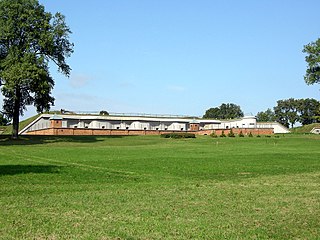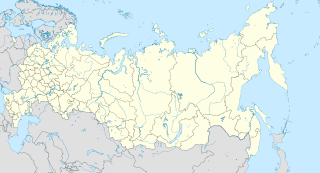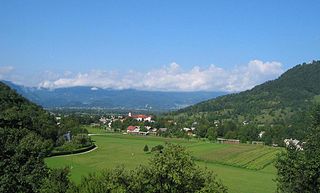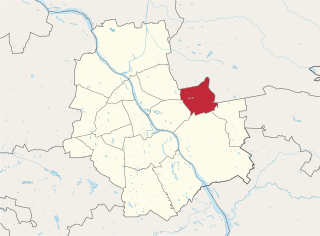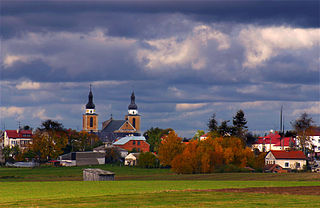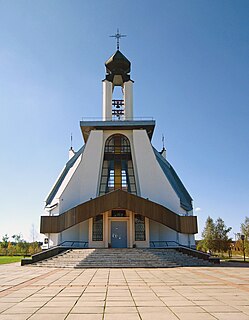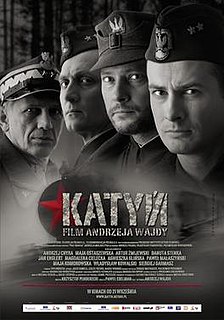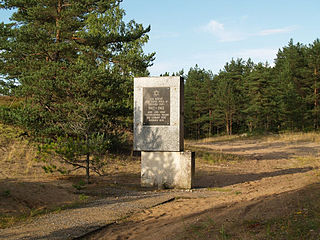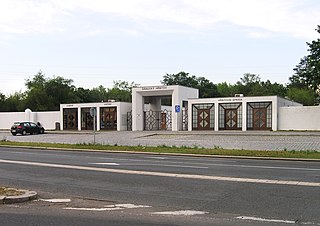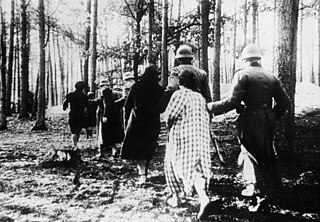



Woodland cemetery in Jeziorko village in the Northeastern part of Poland is located approximately 7 kilometers (4.3 mi) from the town of Łomża along Route 668. The remains of victims murdered by the Nazi troops rest in the cemetery which is among very few with almost completely documented history of events that happened during the Nazi occupation.

Jeziorko is a village in the administrative district of Gmina Piątnica, within Łomża County, Podlaskie Voivodeship, in north-eastern Poland. It lies approximately 6 kilometres (4 mi) north-east of Piątnica, 8 km (5 mi) north-east of Łomża, and 68 km (42 mi) west of the regional capital Białystok.

Poland, officially the Republic of Poland, is a country located in Central Europe. It is divided into 16 administrative subdivisions, covering an area of 312,696 square kilometres (120,733 sq mi), and has a largely temperate seasonal climate. With a population of approximately 38.5 million people, Poland is the sixth most populous member state of the European Union. Poland's capital and largest metropolis is Warsaw. Other major cities include Kraków, Łódź, Wrocław, Poznań, Gdańsk, and Szczecin.

Łomża is a city in north-eastern Poland, approximately 150 kilometres to the north-east of Warsaw and 80 kilometres (50 mi) west of Białystok. It is situated alongside the Narew river as part of the Podlaskie Voivodeship since 1999. Previously, it was the capital of the Łomża Voivodeship from 1975 to 1998. It is the capital of Łomża County and has been the seat of the Roman Catholic Diocese of Łomża since 1925.
Three mass graves are related to three executions that took place there. First, in June 1942 (the exact date is still unknown), approximately 60 elderly people from a nursing home of nearby Pieńki Borowe were murdered. The names of 13 victims were identified with the majority still remaining unknown. Second, on the night of June 29/30, 1943, the military police executed 62 political prisoners transported to the Jeziorko forest from the prison in Łomża. The third grave is a burial site of 52 victims, including children and elderly, members of more than a dozen of families arrested as hostages in their homes in Łomża at dawn on July 15, 1943. They were taken to the prison and then transported to the Jeziorko forest where they were executed. The execution was carried out by a special unit known as the Müller group (after the name of its commander) created by Erich Koch, the East Prussia Gauleiter, i.e., a district leader in Nazi Germany who served as a provincial governor.

Erich Koch was a Gauleiter of the Nazi Party (NSDAP) in East Prussia from 1928 until 1945. Between 1941 and 1945 he was Chief of Civil Administration of Bezirk Bialystok. During this period, he was also the Reichskommissar in Reichskommissariat Ukraine from 1941 until 1944. After the Second World War, Koch stood trial in Poland and was convicted in 1959 of war crimes and sentenced to death. The sentence was commuted to life imprisonment a year later.

A Gauleiter was the party leader of a regional branch of the Nazi Party or the head of a Gau or of a Reichsgau. The word can be singular or plural, depending on the context. Gauleiter was the second highest Nazi Party paramilitary rank, subordinate only to the higher rank Reichsleiter and to the position of Führer. During World War II, the rank of Gauleiter was obtained only by direct appointment from Adolf Hitler.
In autumn of 1944, a German unit (Sonderkommando 1005) exhumed the corpses and burned them to obliterate the evidence of the murders.

The Sonderaktion 1005, also called Aktion 1005, or Enterdungsaktion began in May 1942 during World War II to hide any evidence that people had been murdered by Nazi Germany in Aktion Reinhard in occupied Poland. The operation, which was conducted in strict secrecy from 1942–1944, used prisoners to exhume mass graves and burn the bodies. These work groups were officially called Leichenkommandos and were all part of Sonderkommando 1005; inmates were often put in chains in order to prevent escape.
In spring of 1945, after Nazi forces left the Łomża region, the cemetery in the Jeziorko forest with three mass graves was created by the efforts of inhabitants of Łomża. In 2005, the Council for the Protection of Struggle and Martyrdom Sites acknowledged the cemetery as the Site of National Remembrance.
The Council for the Protection of Struggle and Martyrdom Sites is a Polish government body charged with the preservation of historical sites of wartime persecution of the Polish nation. It was set up by Act of Parliament on 2 July 1947 and, since 1988, is under the direct responsibility of the Prime Minister's Office.
